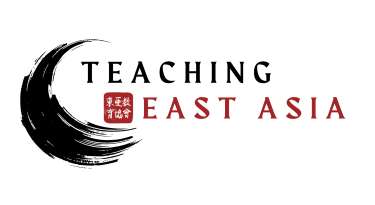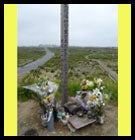Effects of the Kantō Tōhoku Earthquake, 2011
By Kazuko Stone with Laurel Singleton
Lesson (pdf)
Handouts (pdf)
Assessment (pdf)
Introduction:
In this lesson, students consider the effects of the Kantō Tōhoku earthquake, tsunami, and subsequent nuclear meltdowns at the Fukushima Daiichi Nuclear Power Plant. They use photographs, a primary source, and Internet research to identify effects, categorize those effects according to the type of effect (environmental, emotional, economic, etc.), and identify whether the effects were felt locally (in Japan) or globally. They synthesize the information they have gathered to create a photo essay with a thesis statement and supporting evidence in the form of photographs or quotations.
You may find it useful in preparation for teaching this lesson to view the ClassApp video, “Voices from Japan”: 3.11 through Tanka Poetry, which provides useful background, as well as teaching ideas for using poetry, specifically tanka, to teach about the tragedies of 3.11.
Objectives:
After completing this lesson, students will be able to:
- Identify and categorize local and global effects of the Kantō Tōhoku Earthquake on March 11, 2011.
- Demonstrate understanding of cause and effect, particularly related to natural disasters.
- Explain how human actions can worsen or ameliorate the effects of natural disasters.
- Create a photo essay incorporating a thesis statement and supporting evidence.
Guiding Question:
- How did the Kantō Tōhoku Earthquake of 2011 affect local Japanese communities, as well as communities around the globe?
Standards and Guidelines:
World History Content Standards
- World History Across the Eras
- Standard 1: Long-term changes and recurring patterns in world history.
- 5-12: Analyze ways in which human action has contributed to long-term changes in the natural environment in particular regions or worldwide.
National Geography Standards
- Essential Element V: Environment and Society
- Standard 14: How human actions modify the physical environment
- Standard 15: How physical systems affect human systems
Common Core State Standards: Grades 6-12 Literacy in History/Social Studies
Key Ideas and Details
- CCSS.ELA-Literacy.RH.9-10.3: Analyze in detail a series of events described in a text; determine whether earlier events caused later ones or simply preceded them.
Plan for Assessment:
The photo essay assignment that concludes the lesson is intended as the assessment for the lesson. The photo essay should reflect in-class learning and research about the effects of Japan’s 3.11 earthquake, tsunami, and/or nuclear meltdown. A checklist is available to establish expectations and for teacher use or peer review.
Time Required: Three or four 50-minute class periods
Materials:
Materials Provided
Handouts
- Thank You Note from a Community Member (reading level: 6.7)
- Effects of the 2011 Kantō Tōhoku Earthquake Worksheet
- Researching the Effects of the 2011 Earthquake, Tsunami, and Nuclear Accident
Assessment Tools
- Essay Directions
- Photo Essay Checklist
Online Resources
- Map: Impact of Japan Tsunami and Earthquake
- Japan Earthquake: Before and After
- Satellite Photos of Japan, Before and After the Quake and Tsunami
- Optional: Padlet
Other Materials
- Map of Japan
- Computers with Internet access and printing capability
- Equipment for projecting images from the Internet
- Optional: Self-adhesive notes in two colors and enlarged copy of Effects of the 2011 Kantō Tōhoku Earthquake Worksheet
- Materials for making photo essays (flip chart paper, markers, tape/glue sticks, etc.).
Implementation:
Day 1
- Ask students why the date 9/11 has such significance for Americans. (It marked a day of fear, confusion, and loss for the United States—the terrorist attacks of September 11, 2001.) Point out that 3.11 is a similarly significant date for Japanese. Ask if any students know why this is true. (On March 11, 2011, Japan was hit by the strongest earthquake in its recorded history, followed by a massive tsunami and damage to the Fukushima Daiichi Nuclear Power Plant, resulting in radioactive contamination of a significant area around Fukushima.)
- Point out the Kantō and Tōhoku regions on a map of Japan (you may want to use the map to show the location of the earthquake) and project a few before-and-after images of the damage in these areas; the following sites provide useful photographs (showing five or six pairs of before-and-after photos is sufficient):
- Australian Broadcasting Corporation
- The New York Times
- As students view the photos, ask them to identify effects they see. Record their answers on the board (or ask a student to do so).
- Distribute the Thank You Note from a Community Member and allow time for students to read it or read it aloud with the class.
- Conduct a class discussion of what the letter reveals about the effects of the earthquake and tsunami, drawing out both physical effects and emotional/human effects. Record all effects mentioned on the board.
- Draw students’ attention to the list of effects you have compiled and ask:
- Where were these effects felt? (Primarily in and around the Kantō and Tōhoku regions and possibly in other parts of Japan) Do you think effects were felt beyond Japan? (Accept all answers.)
- What types of effects have we listed here? In other words, if we were going to sort the effects into categories, what would the categories be? (Accept students’ answers; some possible categories include political, economic, social/cultural, emotional, geographic or environmental, technological.)
- Distribute the Effects of the 2011 Kantō Tōhoku Earthquake Worksheet and go over the categories listed, helping students define each category. Allow time for students, working in groups of three or four, to categorize the effects the class has listed to this point in the lesson. This could also be done as a class, using an enlarged copy of the worksheet; if you choose this option, give students two colors of self-adhesive notes, one for local effects and one for global effects. They can write one effect on each note and post it in the appropriate category on the enlarged worksheet. A third option would be to use an online post-it site such as Padlet (http://padlet.com).
- Share and discuss the results of the categorizing.
- Tell students they will expand their analysis of the effects of the earthquake and tsunami in the next phase of the lesson.
Days 2 and Optional Day 3
- Remind students of their work in the previous class period by asking: When you think about the effects of the earthquake and tsunami that we looked at previously, would you say they show how the environment affects humans or how humans affect the environment? (How the environment affects humans) Tell students that part of the story of the 3.11 earthquake and tsunami shows how humans affect the environment.
- Provide some details about the meltdown of three reactors at the Fukushima Daiichi Nuclear Power Plant in the days following the March 11, 2011 earthquake and tsunami (you may want to use a timeline from an internet source).The natural disasters damaged the plant, causing three reactors to meltdown and allowing radioactive material to be released from the plant. The environment in hundreds of square miles in the area around the plant was contaminated, and at least 160,000 people had to be evacuated from their homes. It took four years for even a small part of the area to be declared safe for human habitation, and many former residents have decided not to return. Ask: How does this aspect of the tragedies that occurred in Japan in 2011 illustrate that humans affect the environment and that human actions can worsen or ameliorate the effects of natural disasters? (The natural disaster affected human-built structures which, when damaged, released material harmful to the environment. Public policy in Japan encouraged use of nuclear power, which was ultimately harmful to the environment and made the effects of the natural disaster even worse.) Ask: How might this aspect of the tragedies illustrate global effects of the natural and human disaster? (Radiation might travel via air or water to other parts of the world. Radiation might contaminate farming and fishing products for export. The accidents might cause other countries to rethink their policies on nuclear energy.)
- Tell students they are going to be working in groups of three or four (these might be the same groups from the previous day) to do Internet research that will help them better understand the effects of the earthquake, tsunami, and subsequent nuclear accident. Distribute the Researching the Effects of the 2011 Earthquake, Tsunami, and Nuclear Accident handout and go over the instructions with students, making sure they understand they are to use the Effects of the 2011 Kantō Tōhoku Earthquake Worksheet to record the results of their research. Also be sure they realize that they will need photos from their research for their final product.
- Allow the rest of the class period for research. If time permits, you may allot another day for research or encourage students to continue their research as homework.
Day 4
- Tell students that today they are going to analyze the information they have found and synthesize it into a photo essay. Distribute the Photo Essay Directions to students, along with the Photo Essay Checklist, and go over both, ensuring that students understand the instructions. Point students to the materials available for making their photo essays (flip chart paper, markers, tape/glue sticks, etc.). Allow most of the class period for constructing the photo essays.
- Have students post their photo essays around the classroom. Assign each group to use the checklist to assess the photo essay posted to the right of (or clockwise from) their own work.
- Conduct a concluding discussion focused on the lesson’s guiding question: How did the Kantō Tōhoku Earthquake of 2011 affect local Japanese communities, as well as communities around the globe?
Extensions:
- Explore with students how literature—poetry, fiction, essays, memoir—can help people to understand disaster. Choose a work from March Was Made of Yarn; The Voices from Japan tanka collection; or from the online collection Japanese Earthquake Charity Literature for students to read and discuss.
- Challenge students to research and analyze how visual and performance artists responded to the earthquake. When they have completed their research, they might create their own artworks to reflect personal responses to the 3.11 tragedies.
Resources and References:
Edge, Don. Inside Japan’s Nuclear Meltdown. Frontline. WGBH and PBS, February 28, 2012.
Japan Earthquake: Before and After. Australian Broadcasting Corporation, 2011.
Japan's Killer Quake. NOVA. WGBH and NOVA, February 27, 2013.
Kingston, Jeff. Natural Disaster and Nuclear Crisis in Japan: Response and Recovery after Japan's 3/11. London: Routledge, 2012.
Krauth, Kathleen. “Voices from Japan”: 3.11 through Tanka Poetry. National Consortium for Teaching about Asia.
Luke, Elmer, and David Karashima, eds. March Was Made of Yarn. New York: Vintage Books, 2012.
“Massive Earthquake Hits Japan.” Boston Globe, March 11, 2011.
Map: Impact of Japan Tsunami and Earthquake. Cable News Network, 2011.
Samuels, Richard J. 3.11: Disaster and Change in Japan. Ithaca and London: Cornell University Press, 2013.
“Satellite Photos of Japan, Before and After the Quake and Tsunami.” The New York Times, March 13, 2011.
Voices from Japan. American School in Japan.
Waseda Bungaku’s Charity Project: Japan Earthquake Charity Literature. Waseda Bungaku.
The Program for Teaching East Asia at the University of Colorado gratefully acknowledges the support of the United States-Japan Foundation in the development of Cultural Encounters: Teaching Japan in World History.
Created 2015 Program for Teaching East Asia, University of Colorado.

Cultural Encounters
- Ancient Japan
- Medieval Japan
- Unifying & Tokugawa Japan
- Meiji Japan
- Japan at War
- Contemporary Japan


